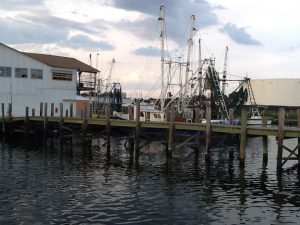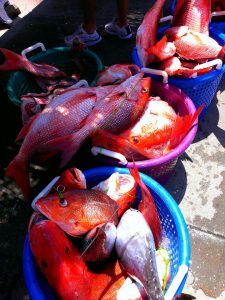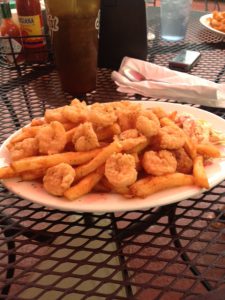Shrimp, oysters, blue crab and fish have been harvested from the Pensacola Bay System (PBS) for decades, although there has been a decline in all in recent years. Annual landings (in pounds) have ranged from
- Fish 66,000 – 4,600,000 (most are scaienids)
- Brown shrimp 43,000 – 906,000
- Oysters 0 – 492,000
- Blue crab 400 – 137,000
There is a concern about the safety of seafood harvested from our estuary… sort of. Many local residents and visitors ask frequently about the safety of these products. However, when programs are held to provide this information they are not well attended, and when articles are posted – few view them. I think there is a concern for the safety of seafood products, particularly those from our estuaries – so I cannot explain the lack of interest in the presentations and articles.
One contaminant that gets a lot of press is mercury. The toxic form of mercury is methylmercury. This form of mercury impairs brain development of fetuses – hearing, vision, and muscle function in adults. Studies suggests that the primary source of mercury in the waters of the PBS is the atmosphere. Advisories have been issued for Escambia, Blackwater, and Yellow Rivers. There have also been advisories for local largemouth and king mackerel. This is one of the metals whose concentrations within the PBS is higher than neighboring estuaries – especially in our bayous (see https://blogs.ifas.ufl.edu/escambiaco/2018/06/13/restoring-the-health-of-pensacola-bay-what-can-you-do-to-help-bioaccumulation-of-toxins/.) Florida Department of Environmental Protection (FDEP) has issued Total Maximum Daily Loads (TDMLs) for mercury in the PBS.
So How Much is Too Much?
For monitoring purposes, total mercury (THg) is easier and less expensive to than the toxic form methylmercury (MHg). Many believe the amount of THg is equivalent to the concentration of MHg, and so it is used as a proxy for MHg.
Both the U.S. EPA and the FDEP recommend concentrations of THg not be higher than 0.3 ppm, and 0.1 ppm for pregnant women (or women planning a pregnancy).
Fish
Since 2000, four studies have been conducted on six species of fish in the PBS. Concentrations of THg ranged from 0.02 – 0.88 ppm and averaged between 0.2 – 0.4 ppm.
Blue Crab
Two studies have been conducted since 2007 found mercury concentrations ranged from 0.07 – 1.1 ppm.
Oysters
30 years ago, studies were finding concentrations of THg in oysters around 0.02 ppm. Repeated studies between 1986 and 1996 found an increase to 0.3 ppm.
Overall
Studies suggest that shrimp and oysters have lower concentrations of THg than blue crab and fish.
How often have samples exceeded the safe levels suggested by EPA, FDEP, and FDA?
| Group | Recommended highest level | % of times samples from PBS exceeded this limit |
| Subsistence Fishermen | 0.049 ppm | 50-90%
(89% for blue crab and oysters) |
| Pregnant females | 0.1 ppm | 50-90%
(88% for blue crab) |
| General public | 0.3 ppm | 5-20%
(12% for blue crabs) (27% for fish) |
| Food and Drug Administration recommendation | 1.0 ppm | 0% |
The concern for mercury in local seafood has led to a reduction of consuming all seafood by pregnant women – period. Recent studies have shown this can have negative effects on the developing baby as well. The recommendation is to avoid fish that have been tested high in THg. Most of these are high on the food chain – such as king mackerel, shark, and swordfish. You can find the latest on seafood safety and advisories at https://myescambia.com/our-services/natural-resources-management/marine-resources/seafood-safety. Another piece of this story is the belief, by many, that selenium can lower the toxicity of MHg. Many believe that molar ratios of selenium and mercury greater than 1.0 can reduce the toxicity. However, there have been no studies on molar ratios of these elements in the PBS.
The bottom line on this issue is to be selective on the seafood products you consume.
Reference
Lewis, M.J., J.T. Kirschenfeld, T. Goodhart. 2016. Environmental Quality of the Pensacola Bay System: Retrospective Review for Future Resource Management and Rehabilitation. U.S. Environmental Protection Agency. Gulf Breeze FL. EPA/600/R-16/169.
- Searching for Mangroves in the Florida Panhandle - April 6, 2024
- The Swallow-tailed Kites are Back - March 30, 2024
- Beach Wildlife Walk – Late Winter - March 22, 2024



